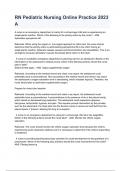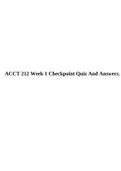RN
Pediatric
Nursing
Online
Practice
2023
A
A
nurse
in
an
emergency
department
is
caring
for
a
school-age
child
who
is
experiencing
an
anaphylactic
reaction.
Which
of
the
following
is
the
priority
action
by
the
nurse?
-
ANS
Administer
epinephrine
IM
Rationale:
When
using
the
urgent
vs.
non-urgent
approach
to
client
care,
the
nurse
should
determine
that
the
priority
action
is
administering
epinephrine
IM
to
the
child.
During
an
anaphylactic
reaction,
histamine
release
causes
bronchoconstriction
and
vasodilation.
This
is
an
emergency
because
ultimately
it
causes
decreased
blood
return
to
the
heart.
A
nurse
in
a
pediatric
emergency
department
is
planning
care
for
an
adolescent.
Based
on
the
information
in
the
adolescent's
medical
record,
which
of
the
following
actions
should
the
nurse
plan
to
take?
Select
all
that
apply.
-
ANS
Apply
supplemental
oxygen
Rationale:
According
to
the
medical
record
and
chest
x-ray
report,
the
adolescent
could
potentially
have
a
pneumothorax.
Also
according
to
the
medical
record
and
chest
x-ray
report,
the
adolescent's
oxygen
saturation
level
is
decreasing,
which
indicates
hypoxia.
Therefore,
the
nurse
should
plan
to
administer
supplemental
oxygen.
Prepare
for
chest
tube
insertion
Rationale:
According
to
the
medical
record
and
chest
x-ray
report,
the
adolescent
could
potentially
have
a
pneumothorax.
A
pneumothorax
is
the
presence
of
air
in
the
pleural
cavity,
which
results
in
decreased
lung
expansion.
The
adolescent
could
experience
dyspnea,
tachypnea,
tachycardia,
hypoxia,
and
pain.
This
requires
prompt
intervention
by
the
provider,
such
as
the
placement
of
a
chest
tube
into
the
thoracic
cavity
to
remove
air
and
fluid
from
the
pleural
space,
if
present,
allowing
the
lung
to
re-expand.
A
nurse
in
an
emergency
department
is
caring
for
a
school-age
child
who
has
epiglottitis.
Which
of
the
following
actions
should
the
nurse
take?
-
ANS
Monitor
the
child's
oxygen
saturation
Rationale:
The
nurse
should
monitor
the
child's
oxygen
saturation
level
because
the
child
is
experiencing
acute
respiratory
distress
and
it
is
necessary
to
determine
if
the
child
is
responding
to
treatment.
A
nurse
is
providing
teaching
about
play
activities
for
social
development
to
the
guardians
of
a
preschooler.
Which
of
the
following
play
activities
should
the
nurse
recommend
for
the
child?
-
ANS
Playing
dress-up Rationale:
The
nurse
should
instruct
the
guardians
that
at
the
preschool
age,
play
should
focus
on
social,
mental,
and
physical
development.
Therefore,
playing
dress-up
is
a
recommended
play
activity
for
this
child.
A
nurse
is
receiving
change-of-shift
report
for
four
children.
Which
of
the
following
children
should
the
nurse
see
first?
-
ANS
A
school-age
child
who
has
sickle
cell
anemia
and
reports
decreased
vision
in
the
left
eye
Rationale:
When
using
the
urgent
vs.
non-urgent
approach
to
client
care,
the
nurse
should
determine
the
priority
finding
is
a
report
of
decreased
vision
in
the
left
eye.
This
finding
indicates
that
the
child
is
experiencing
a
vaso-occlusive
crisis
and
should
be
reported
to
the
provider
immediately.
Therefore,
the
nurse
should
see
this
child
first.
A
nurse
is
providing
teaching
to
the
parents
of
a
preschooler
who
has
heart
failure
and
a
new
prescription
for
digoxin
twice
daily.
Which
of
the
following
instructions
should
the
nurse
include
in
the
teaching?
-
ANS
"Brush
the
child's
teeth
after
giving
the
medication."
Rationale:
The
nurse
should
instruct
the
parents
to
brush
the
child's
teeth
after
administering
digoxin
to
prevent
tooth
decay
caused
by
the
medication,
which
comes
as
a
sweetened
liquid
to
enhance
the
taste.
A
nurse
is
providing
teaching
to
the
parent
of
an
infant
who
has
diaper
dermatitis.
The
nurse
should
instruct
the
parent
to
apply
which
of
the
following
to
the
affected
area?
-
ANS
Zinc
oxide
Rationale:
Diaper
dermatitis
is
a
common
inflammatory
skin
disorder
caused
by
contact
with
an
irritant
such
as
urine,
feces,
soap,
or
friction,
and
takes
the
form
of
scaling,
blisters,
or
papules
with
erythema.
Providing
a
protective
barrier,
such
as
zinc
oxide,
against
the
irritants
allows
the
skin
to
heal.
A
nurse
is
caring
for
a
client
who
has
been
receiving
IV
fluids
via
a
peripheral
IV
catheter.
When
preparing
to
discontinue
the
IV
fluids
and
catheter,
which
of
the
following
actions
should
the
nurse
plan
to
take?
(Move
the
steps
into
the
box
on
the
right,
placing
them
in
the
order
of
performance.
Use
all
the
steps.)
-
ANS
First,
the
nurse
should
turn
off
the
IV
pump.
Next,
the
nurse
should
occlude
the
IV
tubing,
and
then
remove
the
tape
securing
the
catheter.
Last,
the
nurse
should
apply
pressure
over
the
catheter
insertion
site.
A
nurse
is
assessing
a
school-age
child
who
has
an
acute
spinal
cord
injury
following
a
sports
injury
1
week
ago.
Identify
the
area
the
nurse
should
tap
to
elicit
the
biceps
reflex.
(You
will
find
hot
spots
to
select
in
the
artwork
below.
Select
only
the
hot
spot
that
corresponds
to
your
answer.)
-
ANS
A A
nurse
is
caring
for
a
school-age
child
who
is
receiving
chemotherapy
and
is
severely
immunocompromised.
Which
of
the
following
actions
should
the
nurse
take?
-
ANS
Screen
the
child's
visitors
for
indications
of
infection.
Rationale:
A
child
who
is
severely
immunocompromised
is
unable
to
adequately
respond
to
infectious
organisms,
resulting
in
the
potential
for
overwhelming
infection.
Therefore,
the
nurse
should
screen
the
child's
visitors
for
indications
of
infection.
A
nurse
is
providing
teaching
to
the
parent
of
a
school-age
child
who
has
a
new
prescription
for
oral
nystatin
for
the
treatment
of
oral
candidiasis.
Which
of
the
following
instructions
should
the
nurse
include?
-
ANS
"Shake
the
medication
prior
to
administration."
Rationale:
The
nurse
should
instruct
the
parent
to
shake
the
medication
prior
to
administration
to
disperse
the
medication
evenly
within
the
suspension.
A
nurse
is
teaching
a
group
of
parents
about
infectious
mononucleosis.
Which
of
the
following
statements
by
a
parent
indicates
an
understanding
the
teaching?
-
ANS
"Mononucleosis
is
caused
by
an
infection
with
the
Epstein-Barr
virus."
Rationale:
The
nurse
should
identify
that
mononucleosis
is
a
mildly
contagious
illness
that
occurs
sporadically
or
in
groups,
and
is
primarily
caused
by
the
Epstein-Barr
virus.
A
nurse
is
creating
a
plan
of
care
for
a
school-age
child
who
has
heart
disease
and
has
developed
heart
failure.
Which
of
the
following
interventions
should
the
nurse
include
in
the
plan?
-
ANS
Provide
small,
frequent
meals
for
the
child.
Rationale:
The
metabolic
rate
of
a
child
who
has
heart
failure
is
high
because
of
poor
cardiac
function.
Therefore,
the
nurse
should
provide
small,
frequent
meals
for
the
child
because
it
helps
to
conserve
energy.
A
nurse
is
providing
anticipatory
guidance
to
the
guardian
of
a
toddler.
Which
of
the
following
expected
behavior
characteristics
of
toddlers
should
the
nurse
include?
-
ANS
Expresses
likes
and
dislikes
Rationale:
The
nurse
should
include
that
expressing
likes
and
dislikes
is
an
expected
behavior
of
toddlers.
This
is
the
time
in
life
when
a
toddler
is
developing
autonomy
and
self-concept.
They
will
try
to
assert
themselves
and
frequently
refuse
to
comply.
The
guardian
should
allow
the
child
to
have
some
control,
but
also
set
limits
for
them
so
they
learn
from
their
behavior
and
learn
to
control
their
actions.
A
charge
nurse
is
preparing
to
make
a
room
assignment
for
a
newly
admitted
school-age
child.
Which
of
the
following
considerations
is
the
nurse's
priority?
-
ANS
Disease
process





